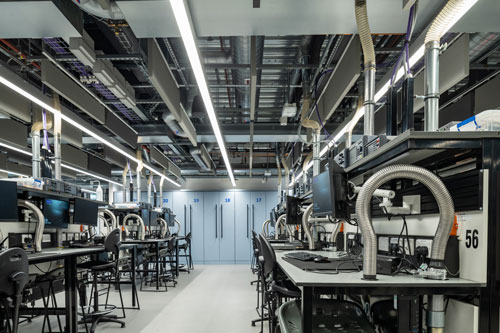How TM66 and 65 is kick-starting our journey to cut carbon

The construction sector is increasingly focused on the issue of embodied carbon and circularity in manufacture. The lighting sector is arguably ahead of the curve. Here Dan Lister, incoming President of the CIBSE Society of Light and Lighting, explains the role that professional institutions can play in effecting real change and why he feels the sector provides a blueprint for how this can be achieved.
CIBSE published its pioneering methodology for calculating the embodied carbon in building services as TM65 back in 2021. The document was written to enable building services engineers to calculate the amount of embodied carbon within mechanical, electrical and public health equipment.
To the lighting industry’s credit, many in the sector adopted this methodology, including lighting designers, specifiers, product designers and manufacturers to help evaluate the carbon embodied within luminaires and lighting equipment.
In recognition of this, in June 2023 CIBSE published TM65.2 Lighting: a more focused version of TM65 written specifically for the lighting sector. This document, and the expanded embodied carbon calculator, built on the methodology in the original document. It applied variations, where needed, to provide more specific guidance and a methodology better suited to lighting equipment and the lighting industry.
As every lighting designer knows, each light fitting added to a drawing or installed on a project will add to the total carbon emissions associated with that project. This total is based on embodied carbon emissions, those associated with material sourcing, manufacturing, transport and the eventual disposal of the project, along with the more familiar operational carbon emissions resulting from energy used by a product during its lifetime.
Until recently, it was standard practice for lighting designers to specify luminaires based on efficacy, light distribution, colour rendering, colour temperature and aesthetics.
Very rarely was a product’s embodied carbon considered in a specification because the information needed to make informed decisions and to compare products was not easily available.
The benefit of TM65.2 is that it enables lighting designers to make informed choices beyond that of comparing operational carbon emissions. It offers an accessible, fast, economically advantageous solution that allows self-assessment of a lighting product’s embodied carbon based on materials within its construction.
Importantly, TM65.2 does not aim to replace Environmental Product Declarations (EPDs), indeed it cannot, but rather it allows initial conservative embodied carbon estimations for luminaires and lighting equipment to be made. This allows for a quick and cost-effective way to establish an embodied carbon calculation for products, allowing for whole-project calculation of emissions right now.
Through their work, CIBSE and SLL have provided the lighting industry with a stop-gap methodology, enabling an assessment of embodied carbon until a harmonised life cycle assessment methodology, on which EPDs are based, is universally accepted.
TM65 and, more specifically, TM65.2 epitomises what the Society of Light and Lighting and CIBSE is about. The professional institution provides expertise and guidance, inviting and enabling participation by industry practitioners.  It is this collaborative effort that is key, allowing practicing specialists to contribute to a methodology which will therefore be relevant and accessible.
It is this collaborative effort that is key, allowing practicing specialists to contribute to a methodology which will therefore be relevant and accessible.
Such collaboration also involves an immediate element of buy-in rather than relying on guidance written and imposed by an external body.By providing expertise and producing robust, practical methodologies, the guides have helped the lighting industry take its first steps to evaluating embodied carbon emissions and, ultimately, in helping the Built Environment play its part in addressing the climate emergency.
Alongside embodied carbon, a full understanding of a lighting product’s sustainability should also include a cradle-to-cradle analysis of all energy and resource inputs with a view to keeping products and materials in use for as long as possible while minimising their impact on the environment. The lighting industry is ahead of the curve here too, publishing TM66 – Creating a circular economy in the lighting industry back in 2021.
This CIBSE Technical Memorandum is intended to provide a framework for industry action. Like TM65, it too is the result of cross-industry collaboration and an industry desire to provide practical guidance and tools to enable the development of a circular sustainable approach to lighting and building services engineering more broadly.
TM66 sets out sector-by-sector how the lighting industry can adopt circular principles along with case studies to demonstrate the circular economy in action. It includes the Circular Economy Assessment Methods to give manufacturers and specifiers targeted, useable, independent metrics to compare products and their sustainable credentials.
The significance of TM65.2 and TM66 to the lighting industry is underscored by reference to one or both documents by all three of the shortlisted entries from lighting manufacturers in this year’s CIBSE Building Performance Awards (BPAs).
Whitecroft Lighting, won the BPA Embodied Carbon Award category for its cradle-to-cradle approach to the design of its products combined with its use of modularity to enable more efficient maintenance of products to reduce waste (pictured right is University of Manchester project by Whitecroft Lighting). The manufacturer also collaborated with the Society of Light and Lighting and CIBSE on drafting TM66.
Highly commended in the same BPA award category was EGG lighting. The re-manufacturer used CIBSE TM65 methodology for its embodied carbon assessments across all its refurbished (or remanufactured) luminaire products.
I think that the progress the lighting industry has made towards understanding, calculating and minimising the embodied carbon emissions associated with its products is hugely impressive. The sector is well ahead of many other industries within construction and demonstrates what can be achieve with strong leadership from an active and well-supported professional association.
I’d go so far as to invite other product groups within construction to consider how they might emulate the work done here to speed up progress towards zero carbon buildings.
• Diary date: Circular Lighting Live 2024, Recolight’s flagship conference and exhibition, takes place on Wednesday 9 October 2024 at the Royal College of Physicians in London. Free to specifiers, Circular Lighting Live 2024 will feature leading experts, specifiers and policy makers who will share their insights into forthcoming standards and legislation, emerging technologies and new business models. More info: www.circularlighting.live


